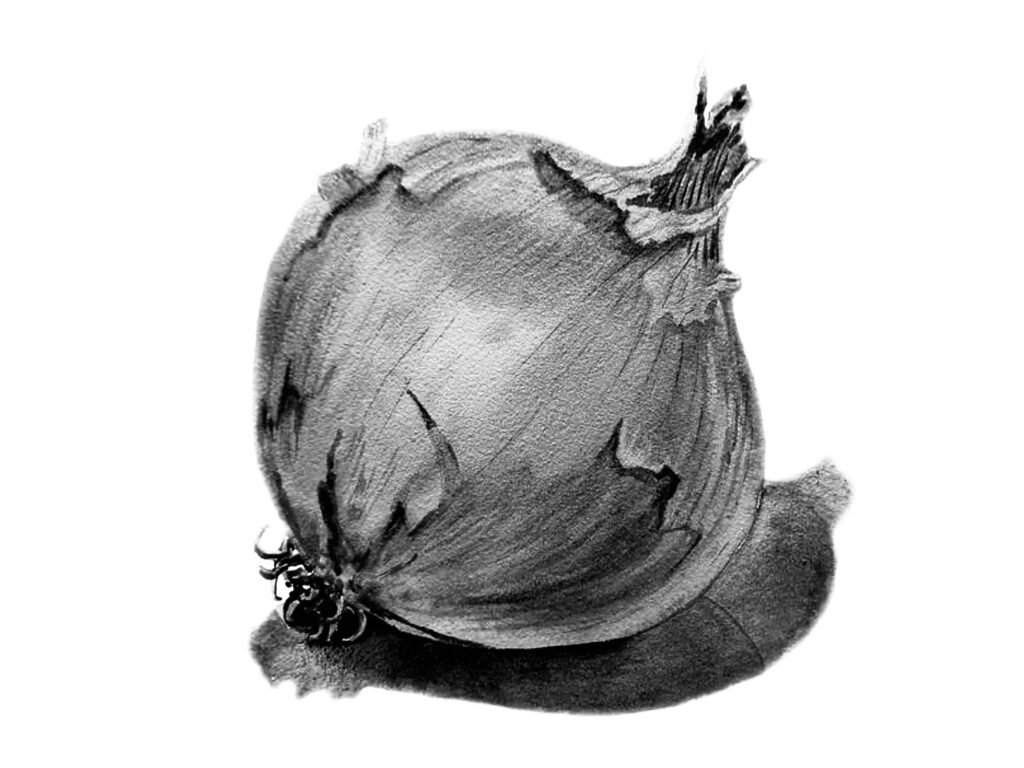
THE HISTORY OF ONIONS
Many archaeologists, botanists, and food historians believe onions originated in central Asia, while other research suggests onions were first grown in Iran and West Pakistan.
It is presumed that our predecessors discovered and started eating wild onions very early, long before farming or even writing was invented. Very likely, this humble vegetable was a staple in the prehistoric diet.
Most researchers agree the onion has been cultivated for 5000 years or more. Since onions grew wild in various regions, they were probably consumed for thousands of years and domesticated simultaneously all over the world. Onions may be one of the earliest cultivated crops because they were less perishable than other foods of the time, were transportable, were easy to grow, and could be grown in a variety of soils and climates. In addition, the onion was useful for sustaining human life. Onions prevented thirst and could be dried and preserved for later consumption when food might be scarce. While the place and time of the onion’s origin is still a mystery, many documents from very early times describe its importance as a food and its use in art, medicine, and mummification.
In ancient Egyptian priests saw onions as objects of worship with the inner rings symbolizing eternity. The Pharaoh King Ramses IV was entombed with onions in his eye sockets. Paintings of onions appear on the inner walls of the pyramids depicted on banquets tables of royal feasts and on the altars of the gods.
Ancient Greek athletes consumed large quantities of them thinking it would “balance” their blood and improve their athletic prowess. Later, after conquering Greece, Romans ate onions regularly and also rubbed it on their gladiators to tone their muscles.

Medical uses for onions started long ago in the history of civilization and are still used in some areas around the world today. During the Civil War, General Ulysses S. Grant sent a warning to the War Department in Washington, “I will not move my army without onions.” This curious message reflects the fact that, throughout history, onions were valued as much for their medicinal properties as for their culinary use. While we have more sophisticated ways of treating battle wounds today than using onions, their healthful nature and ability to add culinary interest to bland dishes makes onion the third most important vegetable in the world.
Throughout antiquity the medicinal properties of onion were widely avowed. As a result, it was used by ancients to treat a wide array of conditions ranging from irregularity to hair loss. Early Americans used wild onions to treat colds, coughs, and asthma and breathing problems. Today, onion is still considered a health food. Its consumption has been associated with a reduced risk of cancer, heart disease and diabetes because of its high level of phenolic and flavonoid compounds with high antioxidant activity. In general, onions with greater pungency have higher antioxidant activity than milder types.
There are three basic groups of onions: all are used more to flavor dishes than as a main course themselves. The common onion is known only in cultivation and is the most important of the three. This is the type of onion we plant in our gardens in the spring. It produces a single, large bulb that usually matures by mid-summer in our climate. Green onions are simply plants of this species that are pulled before the bulb is well-formed. The common onion is able to produce seed which is its primary means of propagation.
Onions are not able to survive frost or cold weather under 50 degrees Fahrenheit, so if you plant them outside too early in the spring they will die. And if you plant them too late, your onions won’t produce a harvest before the first frost arrives in the fall.
Common onion is spring-planted and may be grown from sets, transplants or seeds. In all cases planting should be done as soon as the soil can be worked in the spring. Onion sets are the most common means of planting onions. ‘Sets’ are small bulbs that develop quickly to produce green onions or allowed to mature to produce (dry) bulbs. To produce green onions plant the sets in a well-drained soil about an inch apart. For larger dry bulbs, sets should be placed no closer than two inches apart. Small sets are more desirable than larger sets which tend to flower more easily. If flowering occurs, the flower head should be removed as soon as it is visible. Onions which flower form smaller bulbs which do not store as well as bulbs harvested from non-flowering plants.
Onion transplants represent seedlings which have been started (usually in the South) by a specialist propagator, pulled at an early stage of growth and shipped north for sale as propagates or “starts”. Large, sweet types such as Sweet Spanish and the Bermuda types frequently are grown from transplants. They should be spaced four to five inches apart within rows spaced 12 to 18 inches apart. As a rule, “sweet” onions do not store as well as the more pungent types.
Onion is a cool season crop with a fairly long maturity (95+ days). Consequently those produced from seeds planted directly outdoors normally do not perform well in areas with hot summers. Instead, when seeds are used, they should be started indoors well in advance of outdoor planting since onion seedlings grow slowly.
Onion also is a photoperiodic plant. Some onion varieties exhibit a short day response and will form bulbs only when the length of day is 12 hours or less. Other varieties are long day in response and form bulbs when day length is at least 15 hours. However they are started, onions grow best under cool temperatures (55 to 75 degrees F) in a loose, workable soil. Onions are sensitive to acid soils and soil pH should be kept in the 6.2 to 6.8 range. As with most vegetables, fertilizers should be applied according to soil test recommendations. When called for, a fertilizer low in nitrogen but high in phosphorus and potassium (e.g. 5-10-10) is recommended.
Weed control is important in onion production since they do not compete well with weeds. Mulching (after onions are established) will help to control weeds as well as conserve moisture. Common production problems with onions include insects such as thrips and onion maggots along with fungal diseases such as downy mildew, neck rot, pink root and smut.
According to Debra Stuart, President of the Rahway Garden Club, “There are three types of onions. I grow long day types. I start my seeds indoors in January, usually harvesting in late July, early August. They are ready for harvest when the tops fall over. They are also good to grow in between tomatoes.”
For more information on growing onions, you can call Rutgers Cooperative Extension 908-654-9852. There is also a great deal of information on the internet.
Thanks to University of Montana and the Smithsonian for the information in this article.
Have a Happy & Safe Spring Everyone,
James
